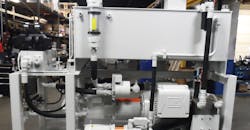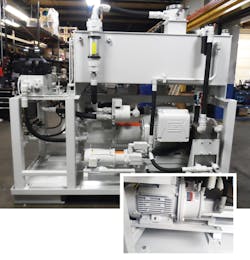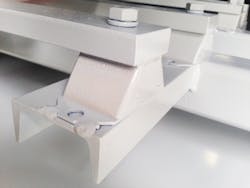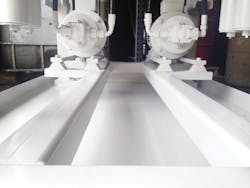Shock Absorbers Quiet Down Hydraulic Test Stand
When testing high-performance machine components, something as simple as choosing the right methods of eliminating noise and vibration can make all the difference. And one way to achieve the most accurate testing possible is with vibration dampers.
Kawasaki Precision Machinery, a well-known manufacturer of hydraulic pumps, motors, and valves, installed a new test stand to measure the performance of its hydraulic pumps for excavators. To ensure they meet Kawasaki’s operating requirements, these pumps go through a series of tests before they’re shipped. And as anyone who has worked in a hydraulic pump test facility knows, this can be a noisy situation. However, plant personnel discovered that installing rubber-metal isolators helped reduce noise and vibration, yielding more accurate results than in the past.
The filter cooling pump is one source of vibration in the test stand. (Inset) Rubber-metal isolators isolate impacts and vibrations from machines and motors, and improve wearing conditions.
Test Stands for Hydraulic Pumps
Testing takes place on a test stand rated at 350 hp and that operates about 10 days each month. The stand weighs about 10,000 lb and rests on ACE rubber isolators. Kawasaki gets 25% more efficiency out of the new stand than with their old models. Other technical features include 350 hp, 2,000 rpm, 5,500 psi and a flow rate of 110 gpm. With the help of the rubber-metal isolators, emits minimal noise.
To help engineers meet a strict set of testing criteria, Kawasaki tests these hydraulic pumps with an automated control system. First, they adjust the valves, oil routing, and control signals until they reach the desired levels. After assembling and tuning the pump, they conduct a simulation that measures how the hydraulic pump reacts in different situations or environments.
Kawasaki uses a curve for measuring flow versus pressure. For a pump to pass this test, it must stay between a set of tolerances at various flow rates and pressures. If it falls outside, the pumps are flagged as a failure and the operator either has to make a modification, or a technician needs to rebuild the pump.
By nature, the test stands create large amounts of noise and vibration, which can affect both working conditions and test results
“Shock-absorbing isolators came into the picture because we needed a way to isolate the noise these stands give off during testing,” says Jim Hoenle, hydraulics system engineer at systems integrator MFP Automation Engineering, Hudsonville, Mich., who designed and built the test stand.
Vibration pads helped test stands withstand the intensity of the rigorous testing system.
Isolators Reduce Noise
Kawasaki needed a way to cut noise in their test stands. Originally, MFP used hard tube plumbing that added to the noise resonance. So they decided to change it out for hoses, which decreased sound. By putting isolation mounts underneath the testing stand, noise levels dropped by 2.5 dBA.
Using the rubber-metal isolators helped these test stands withstand the intensity of this rigorous testing system. The isolators cushion impacts and vibrations from machines and motors and improve working conditions for engineers and the environment, increasing production rates. The rubber-metal isolators help applications like leveling or robust machine feet, tube elements, vibration isolating connection devices and quick attachment elements.
For Kawasaki’s test stand, MFP Automation Engineering used ACE’s COM-52160 and COM-52167 rubber-metal isolators. These heavy-duty mounts excel at preventing vibrations and structure-borne noise from unbalanced masses such as pumps and compressors. They’re used in vertical load applications such as small motors, pumps and compressors.
The COM mounts are maintenance-free and are used in low-frequency ranges of 15 Hz or greater. When mounted in pairs, the natural frequency reduces to between 6 and 10 Hz. Interfering frequencies isolate when they get above 900 rpm. At 25 Hz, there’s a 90% level of isolation. Made from galvanized metal and neoprene, they can withstand temperatures between -22 and 176° F.
Maintenance-free shock absorbers improve efficiency in low frequency application ranges of 15 Hz or greater. In pairs, the frequency reduces to between 6 and 10 Hz.
Less Vibration
ACE isolators also prevent vibration from going into the floor from the pump and drive motor. The vibration got so severe sometimes that workers felt it in their feet during testing.
By isolating the motor in the test stand and its vibration, the isolators removed the low resonant sound that travels through the c-channel. This helps deaden sound by isolating vibration between the motor and frame. Keeping the frame free of vibration is key to reducing noise in the system.
Chris Niemiec is Product Engineer at ACE Controls, Farmington, Mich.
About the Author

Leaders relevant to this article:




